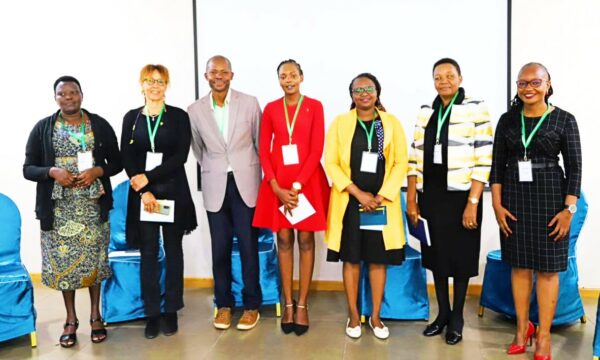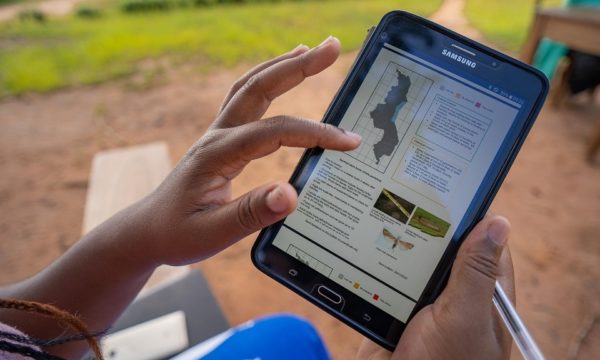
Maize Stalk Borer- Copyright CABI
PRISE inception workshops were held in Kenya, Ghana, and Zambia in March 2017. In the workshops it was recognised by partners that PRISE is a five year project and that the full benefits will only be fully available at the end. However to ensure that we deliver value in the interim we asked partners to prioritise the order in which we should focus on users, crops and pests. Each year a new release of PRISE will incorporate more users, crops and pests driven by partner’s prioritisation of which to tackle first.
Partners prioritised plant doctors/extension workers as the group of users who should receive PRISE first. User interface surveys have now been conducted with 60 plant doctors/extension workers, across the three countries, to ensure the system meets their needs. The results of these surveys will be worked into prototypes which will then be shown to plant doctors to ask for their feedback. The website specification for information output has also been completed.
We agreed with partners that the Baseline release of PRISE, due in October 2017, will only include pests whose outbreaks are driven by temperature and can be calculated with day degree models. Within these parameters we’ve followed their prioritisation and the following pests/pathogens are being investigated for inclusion in PRISE Baseline release.
| Priority crops | Priority pests/pathogens |
| Maize | Stem borer/stalk borer, maize weevil, maize lethal necrosis, maize smut virus, head smut |
| Beans | Bean fly, white fly, vegetable leaf miner |
| Tomato | Tomato leaf miner, thrips, bollworm |
| Cabbage | Diamond back moth |
| Cassava | Cassava mealybug |
| Rice | Stem borer |
| Cocoa | Cocoa mirids |
The above pests/pathogens will be included if sufficient data exists in the literature to model their life-cycles and the life-cycles of the crops on which they occur. Due to the importance partners have placed on incorporating Fall Army Worm into PRISE we have accelerated the work on understanding its life-cycle and how to incorporate non-temperature driven models into PRISE. This is a large undertaking and won’t be ready for Baseline.
System development
Substantial effort is being put into building the computer system for Baseline release and to improve the system architecture for future releases.
We have also been writing protocols and making plans to test the assumptions of the PRISE model with significant fieldwork in Kenya, Ghana and Zambia.
Many partners have provided access to historical pest data sets for validating pest models and we are very grateful for their assistance.
Validation of land surface temperature (LST)
It is important to validate the LST algorithm, used for forecasting pest outbreaks, so that it is as accurate and possible. We have therefore acquired archive LST data from Meteosat, and following analysis of the radiometers available have obtained a radiosonde system. We have also undertaken airborne data acquisitions to support LST validation flights and continued work on spectral emissivity measurement system (lab and field) to derive emissivity parameters for LST retrieval.
User verification of PRISE
We have completed roll-out of electronic devices to plant doctors in Ghana, with appropriate training, for receiving information on pest risk alerts and providing feedback. This is working towards all plant doctors in all three countries having access to electronic devices. Planning has also started on designing a data collection app for pest surveying so that users can add on the ground observations and further improve the forecasting accuracy of PRISE.
Publicity of PRISE
The work of PRISE has been covered in the following publications:
- http://www.scidev.net/sub-saharan-africa/farming/news/farmers-control-pests.html
- http://www.africanfarming.com/early-crop-disease-warnings-zambia/
- http://www.un-spider.org/news-and-events/news/uk-space-agency-funds-project-delivering-pest-risk-information-service-sub
- Article on PRISE in Food Loss and waste in Africa V8, published by Dalberg Research on behalf of Rockefeller Foundation, PRISE introduced at Validation Workshop on Food Security Early Warning Systems Regional Needs Assessment for Eastern and Southern Africa, held in Nairobi
Partnerships signed
Non-Disclosure Agreements have been signed with potential private sector partners in Ghana (Farmerline) and Kenya (ACRE). These will initially work on sharing weather data; generating commercial business plan; and providing feedback on priority pests.
Monitoring and evaluation
Contractors have been signed to undertake the baseline evaluation and fieldwork will commence shortly.
Next steps
- Build further engagement by organising exchange visits for key personnel to UK
- Engagement in imminent M&E baseline studies
- Continued build of the system (Baseline) to focus on prioritised pests with a day-degree based development model
- Collection of multiple pest data sets to calibrate the risk predictions
- Undertake major in-country pest surveys
- Finalise user requirements for plant doctors
- Build on-going PRISE system to be flexible to be able to model risks for extensive range of pests
- Build processes to validate the land surface temperature measurements
- Develop an enhanced website to enhance communications between UK consortium and in-country partners
- Prepare a user requirements document, based on the outputs of the workshops, to be signed between CABI and the key in-country partners
- Organisations from the UK consortium to continue to build the relevant relations with in-country partners according to the priorities identified in the workshops
PRISE is a 5 year Plantwise project, funder by UK Space, to deliver a Pest Risk Information SErvice. You can read more about the project background here. Each quarter we will up date you on project progress.
If you would like to discuss any aspect of PRISE please email PRISE@cabi.org
Related News & Blogs
Early pest warnings and IPM advice are improving food security for maize farmers in Ghana
Pest warnings are changing the way that smallholders in Ghana farm. Smallholder maize farmers in Ghana have long grappled with the challenges posed by crop pests. Over the past few years, this has included the notorious fall armyworm. This voracious in…
14 November 2023




